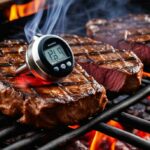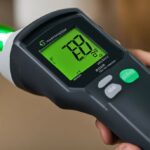Last Updated on 5 months by Francis
When it comes to cooking and food safety, temperature accuracy is crucial. Different factors can affect the temperature of food, including cooking time, heat source, and oven type. Infrared thermometers have gained popularity in recent years as a tool for measuring the surface temperature of food items without making direct contact.
But are infrared thermometers accurate for cooking? In this article, we will delve into the topic and answer this pressing question. We will discuss how infrared thermometers work, their benefits in cooking, and factors that can affect their accuracy. We will also provide practical tips and guidelines on using infrared thermometers effectively in a cooking environment and recommend some of the best options available on the market.
Contents
Key Takeaways
- Infrared thermometers are a popular tool for measuring surface temperature without making direct contact with the food.
- In this article, we will explore the accuracy of infrared thermometers for cooking purposes and compare them with traditional thermometers.
- We will discuss the importance of temperature accuracy in cooking and highlight the factors that can affect the accuracy of infrared thermometers.
- Readers will learn practical tips and guidelines for using infrared thermometers effectively in a cooking environment and explore the advanced features available in some models.
- By the end of this article, readers will have a better understanding of the accuracy and benefits of using infrared thermometers in cooking and be able to make an informed choice.
How Do Infrared Thermometers Work?
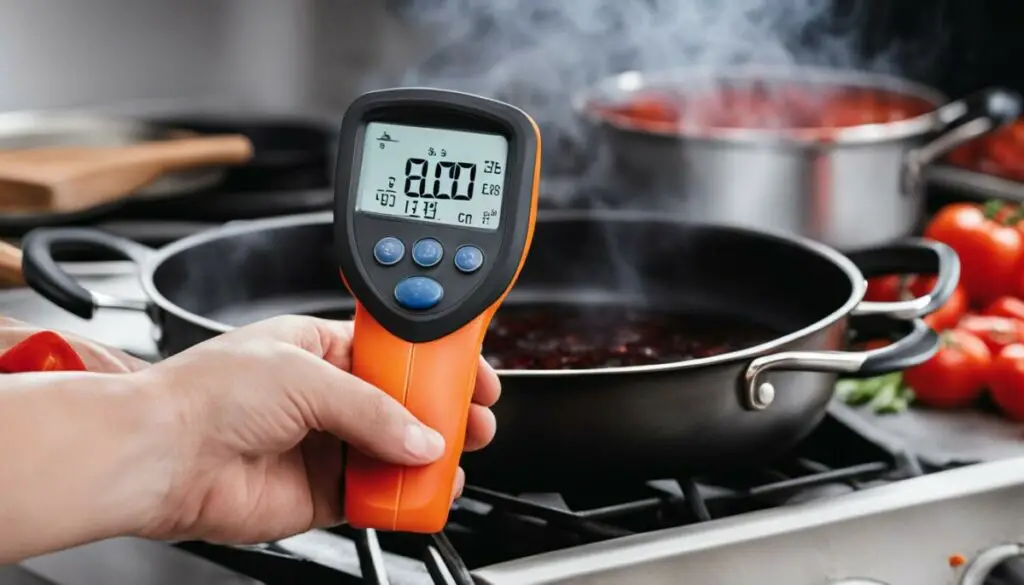
Infrared thermometers are versatile tools that can accurately measure temperatures without making direct contact with the object being measured. They work based on the principle of detecting infrared energy, or radiation, emitted by an object.
The basic structure of an infrared thermometer consists of a lens that focuses the infrared energy onto a detector, which converts the energy into an electrical signal. The signal is then displayed as a temperature reading on the thermometer display.
The Science Behind Infrared Thermometers
All objects with a temperature above absolute zero emit electromagnetic radiation in the infrared region. The amount and wavelength of radiation emitted depend on the temperature and emissivity of the object. Infrared thermometers detect and measure this radiation to determine the temperature of the object.
The lens of an infrared thermometer focuses the infrared energy from the object onto a detector, typically a thermopile. The detector absorbs the energy and generates an electrical signal proportional to the temperature of the object. This signal is then amplified and sent to the display, where it is converted into a temperature reading.
The Advantages of Cooking with Infrared Thermometers
Infrared thermometers offer several advantages over traditional contact-based thermometers in cooking applications. Because they do not touch the object being measured, there is no risk of contamination or damage to delicate foods. They also allow for quick and accurate temperature readings, which can be especially helpful in high-volume kitchens or when cooking multiple dishes simultaneously.
Infrared thermometers are also versatile tools that can be used for a range of cooking tasks beyond temperature measurement, such as checking the temperature of grills, ovens, or refrigerators, or determining the heat distribution of a cooking surface.
“Infrared thermometers are versatile tools that can accurately measure temperatures without making direct contact with the object being measured.”
The Importance of Temperature Accuracy in Cooking

Accuracy is a critical aspect of cooking, and temperature measurement is no exception. Accurate temperature readings are essential for achieving desired results in various culinary processes such as baking, roasting, grilling, and sous-vide cooking. For example, overcooked or undercooked meat can affect its taste, texture, and safety. Similarly, inaccuracies in baking temperatures can lead to unevenly risen or burnt cakes and pastries.
Infrared thermometers offer a convenient and efficient way to measure cooking temperatures. They provide instant and non-contact temperature readings, eliminating the need for guesswork and minimizing errors. However, it is important to note that not all infrared thermometers are accurate for cooking applications. The accuracy of infrared thermometers for cooking depends on various factors such as distance, emissivity, and surface reflections.
When using infrared thermometers for cooking temperature measurement, it is essential to ensure that the thermometer is calibrated and set to the correct emissivity value. Emissivity is the ratio of the radiation emitted by the object to the radiation emitted by a perfect blackbody at the same temperature. Different materials have different emissivity values, and inaccurate emissivity settings can cause errors in temperature readings.
Moreover, distance can also affect the accuracy of infrared thermometers. Most infrared thermometers have a distance-to-spot ratio that indicates the distance from which the thermometer can measure the temperature accurately. As a general rule, the closer the thermometer is to the target, the more accurate the reading will be. However, the thermometer should not touch the target, as this can also impact accuracy.
To overcome potential challenges in using infrared thermometers for cooking temperature measurement, it is essential to follow proper techniques and guidelines. For example, aim the thermometer at the thickest part of the food, avoid measuring in areas with high ambient temperatures or air currents, and maintain a consistent distance from the target.
In conclusion, accurate temperature measurement is crucial for achieving optimal and safe cooking results. Infrared thermometers offer a reliable and efficient way to measure cooking temperatures, but their accuracy depends on various factors. By following proper techniques and guidelines, cooks can ensure accurate and consistent temperature measurements for their culinary creations.
Factors Affecting the Accuracy of Infrared Thermometers

While infrared thermometers can be highly accurate in measuring cooking temperatures, several factors can affect their readings.
Distance
The distance between the thermometer and the target can significantly influence the accuracy of infrared temperature readings. The thermometer should always be positioned at the correct distance from the target as specified by the manufacturer. If the thermometer is too far away, the reading may be inaccurately low, while if it is too close, the reading may be too high.
Emissivity
Emissivity refers to the ability of an object to emit thermal radiation. Different materials have different emissivity values, and this can impact the accuracy of infrared thermometer readings. For example, shiny or reflective surfaces tend to have lower emissivity values, which can result in inaccurately low temperature readings.
Surface Reflections
Surface reflections, such as those from shiny metal surfaces, can also affect the accuracy of infrared thermometer readings. When the thermometer’s laser beam reflects off a shiny surface, it can measure the temperature of the reflective surface instead of the target. To obtain an accurate reading, the thermometer should be aimed at the area of the object that is not reflecting light.
By understanding and accounting for these factors, the accuracy of infrared thermometers in cooking can be greatly improved.
“To obtain optimal readings with infrared thermometers, users should calibrate regularly and take note of the emissivity of the object being measured”
Benefits of Using Infrared Thermometers in Cooking

Using infrared thermometers in cooking can provide a myriad of benefits, making them essential tools for home chefs and professional cooks alike. Here are some advantages of using infrared thermometers for accurate cooking:
1. Precision
Infrared thermometers offer precise temperature measurements, enabling cooks to achieve the desired level of doneness and consistency in their dishes. Unlike traditional thermometers, which require direct contact with the food, infrared thermometers can measure the temperature of the surface from a distance of several inches. This allows for quick and accurate readings without disturbing the food or altering its texture.
2. Efficiency
Cooking with infrared thermometers can save time and energy, as they allow for quick and easy monitoring of food temperatures. They eliminate the need for guesswork and manual testing, enabling cooks to focus on other aspects of their culinary creations. In addition, infrared thermometers can reduce food waste by preventing overcooking or undercooking.
3. Versatility
While infrared thermometers are primarily designed for measuring cooking temperatures, they have various other applications in the kitchen. They can be used to check the heat of ovens, grills, and stovetops, ensuring that they are functioning correctly. They can also measure the temperature of liquids, such as soups and sauces, as well as cold foods, such as salads and desserts.
4. Portability
Infrared thermometers are compact and lightweight, making them easy to carry and store. Many models come with a clip or a hook, allowing them to be attached to an apron or stored in a pocket. This portability makes them ideal for outdoor cooking or when working in a busy kitchen with limited space.
5. Improved Food Safety
Using infrared thermometers can improve food safety by ensuring that food is cooked to the proper temperature, minimizing the risk of foodborne illnesses. They can also monitor the temperature of hot and cold holding units, such as refrigerators and warming trays, helping to maintain safe storage conditions for food.
Overall, infrared thermometers are useful and practical tools for accurate cooking. When looking for the best infrared thermometer for cooking, consider factors such as accuracy, ease of use, and additional features such as adjustable emissivity settings and temperature alarms.
Infrared Thermometer Cooking Tips
Using an infrared thermometer for cooking requires some know-how to get the most accurate results. Here are some tips to keep in mind:
- Know your distance: Infrared thermometers are designed to measure temperatures from a distance, so it’s essential to know the optimal distance for your device. Check the manufacturer’s instructions for distance recommendations, and make sure you’re not too close or too far away from the target.
- Aim for the right spot: Infrared thermometers measure the temperature of the surface they are pointed at, so it’s crucial to aim for the right spot. When measuring the temperature of meat, for example, it’s best to aim for the thickest part of the cut.
- Consider emissivity: Emissivity is the measure of how well an object emits infrared energy, and it can affect the accuracy of your infrared thermometer. Some thermometers allow users to adjust the emissivity setting to improve accuracy for specific materials or surfaces. Check your device’s instructions for how to adjust the emissivity.
- Check for reflections: Surfaces such as metal or glass can reflect infrared energy, leading to inaccurate temperature readings. To avoid this, check for any potential reflections around your target area and aim your thermometer accordingly.
- Practice calibration: Calibration is the process of adjusting your thermometer to ensure it’s measuring accurately. It’s a good idea to test your infrared thermometer’s accuracy periodically and follow the manufacturer’s recommended calibration process.
- Be patient: Infrared thermometers can take a few seconds to give an accurate reading, so be patient and hold the device steady for the recommended amount of time. Avoid moving the thermometer too quickly or shaking your hand while taking a measurement.
With these tips in mind, you’ll be well on your way to using your infrared thermometer effectively in the kitchen.
Recommended Infrared Thermometers for Cooking
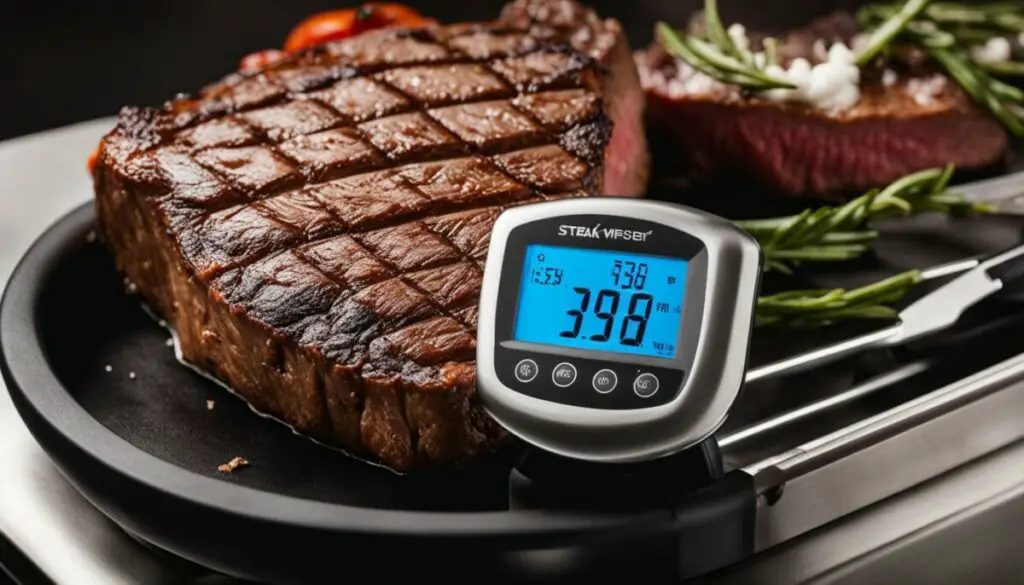
When it comes to selecting the best infrared thermometer for cooking, it’s essential to consider factors such as accuracy, range, durability and additional features. Here are some of the top-rated infrared thermometers suitable for cooking applications:
| Infrared Thermometer | Accuracy | Temperature Range | Additional Features |
|---|---|---|---|
| ThermoWorks IR-GUN-S | ± 2% of reading | -58°F to 1,022°F | Auto-off, 10:1 distance-to-spot (D:S) ratio, low battery indicator |
| Etekcity Lasergrip 800 | ± 2% of reading | -58°F to 1,380°F | Adjustable emissivity, backlit display, auto-off, 12:1 D:S ratio |
| Fluke 62 Max Plus | ± 1% of reading | -22°F to 1,202°F | Dust and water-resistant, dual lasers, drop-tested up to 9.8ft, backlit display |
Each of these infrared thermometers offers excellent accuracy and temperature range suitable for various cooking needs. The ThermoWorks IR-GUN-S and Etekcity Lasergrip 800 have adjustable emissivity settings that allow users to measure different surface types accurately. The Fluke 62 Max Plus comes with an IP54 rating for durability and dual lasers that provide better targeting. Additionally, all three thermometers have an auto-off feature to preserve battery life.
It’s important to note that there are many other infrared thermometers available on the market, but these have been selected based on their popularity, reliability, and affordability. Ultimately, the best infrared thermometer for cooking depends on individual preferences and needs.
Common Misconceptions About Infrared Thermometers in Cooking
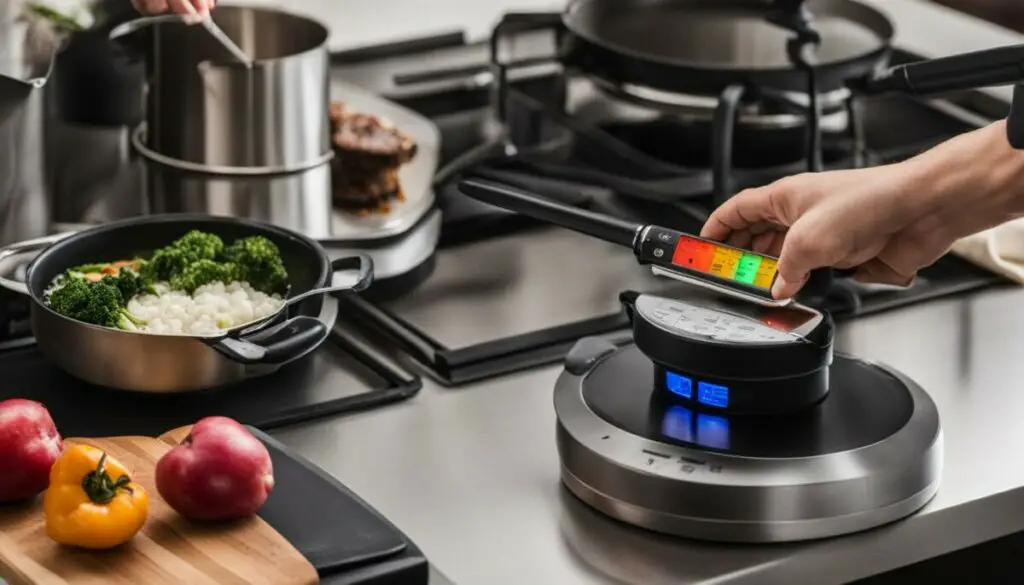
Despite their numerous benefits, there are several misconceptions about infrared thermometers that may prevent people from using them in cooking. In this section, we will debunk some of the common myths and offer accurate information to help you make informed decisions regarding the use of infrared thermometers in your kitchen.
“Infrared thermometers only work on shiny surfaces”
This is not entirely true. While it is true that shiny or reflective surfaces can affect the accuracy of infrared thermometers, advanced models typically come equipped with adjustable emissivity settings that can compensate for this. Additionally, using a small amount of matte black spray paint on shiny surfaces can help increase accuracy.
“Infrared thermometers are difficult to use”
On the contrary, infrared thermometers are very easy to use. Most models are designed to be handheld and offer one-button operation. Simply point the thermometer at the target surface, press the button, and instantly get an accurate temperature reading. The devices are lightweight and compact, making them highly portable and convenient.
“Infrared thermometers are expensive and not worth the investment”
While some models can be pricey, there are also many affordable options available on the market. Considering the precision and efficiency they offer in cooking, investing in an infrared thermometer can ultimately save you time, money, and provide better results in your cooking endeavors.
“Infrared thermometers are only useful for taking surface temperatures”
While infrared thermometers are commonly used for taking surface temperatures, they can also be used for measuring air temperature, making them versatile tools in the kitchen. They can be used to measure the temperature of ovens, grills, and even liquids in a pot or pan.
“Infrared thermometers are not accurate”
This is perhaps the most pervasive myth about infrared thermometers. In reality, when used correctly and under proper conditions, infrared thermometers are highly accurate and offer precise temperature readings. Like any measuring tool, however, they need to be used correctly, taking into consideration the distance, emissivity, and surface characteristics of the target object.
Infrared Thermometers vs Traditional Thermometers in Cooking
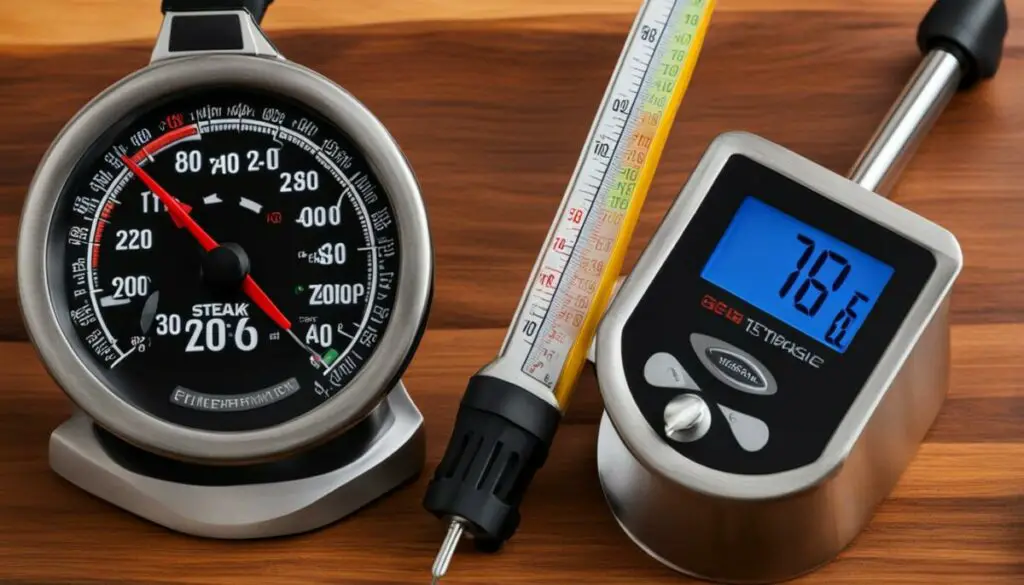
When it comes to measuring temperature in cooking, there are two primary types of thermometers: traditional and infrared. Traditional thermometers, such as probe or meat thermometers, work by direct contact with the food or liquid. In contrast, infrared thermometers measure temperature through the detection of infrared energy emitted by an object without the need for contact.
While both types have their advantages and disadvantages, infrared thermometers offer some distinct benefits for cooking applications. One significant advantage is that they can take readings in just a few seconds without the need to pierce the food, thus avoiding the risk of contamination. They can also measure the temperature of surfaces, making them ideal for tasks like checking the temperature of a grill or oven.
| Comparison | Infrared Thermometers | Traditional Thermometers |
|---|---|---|
| Measurement Time | Quick and easy, usually taking a few seconds. | Slower and may take a few minutes to get an accurate reading. |
| Contact | Non-contact, no risk of contamination or damage to food. | Requires direct contact with the food or liquid. |
| Surface Temperature | Can measure the temperature of surfaces, making them ideal for tasks like checking grill or oven temperature. | Cannot measure surface temperature, only internal temperature. |
| Accuracy | Can be affected by factors such as distance and surface reflectivity, but generally considered to be accurate. | Can be less accurate due to factors such as human error or limited measurement range. |
While infrared thermometers are a versatile and useful tool in the kitchen, they do have some limitations. They may not be suitable for all types of cooking tasks, such as those requiring precise temperature control or extended cooking times. Additionally, their accuracy can be impacted by factors such as distance, emissivity, and surface reflectivity.
Ultimately, the choice between infrared and traditional thermometers will depend on the specific cooking task at hand. For tasks that require quick and non-contact temperature measurement, infrared thermometers are often the preferred choice. However, for tasks that require precise temperature control or extended cooking times, traditional thermometers may be a better option.
Exploring Advanced Features of Infrared Thermometers for Cooking
While standard infrared thermometers are already highly accurate and efficient for measuring cooking temperatures, some models offer advanced features that can further enhance their usefulness in the kitchen.
One of the most significant advanced features of infrared thermometers for cooking is adjustable emissivity settings. Emissivity refers to the degree to which an object emits infrared energy relative to a perfect emitter, which has an emissivity of 1.0. Different materials have different emissivity values, which can affect the accuracy of infrared temperature readings. With adjustable emissivity, users can set the thermometer to match the surface they are measuring, ensuring more precise results.
Another helpful feature is temperature alarms. These alarms can be set to sound when a specific temperature is reached, allowing cooks to be alerted when their food has reached the desired level of doneness or when a critical temperature has been exceeded.
Memory functions are also available on some infrared thermometers, allowing users to store temperature readings for later reference. This can be useful for tracking temperature trends over time or for monitoring temperature changes during cooking processes that involve multiple stages.
Some infrared thermometers also come with an integrated probe, allowing users to take both non-contact and contact measurements with the same instrument. This can offer added versatility and convenience in the kitchen.
| Features | Advantages |
|---|---|
| Adjustable emissivity settings | More precise temperature measurements on different surfaces |
| Temperature alarms | Alerts when food reaches desired temperature |
| Memory functions | Track temperature trends and changes |
| Integrated probe | Measure both non-contact and contact temperatures |
When considering which advanced features to look for in an infrared thermometer for cooking, it’s important to think about which features will be most useful for your specific culinary needs and preferences. Some features may be more beneficial for professional chefs, while others may be more suited to home cooks.
Conclusion:
After exploring the topic of using infrared thermometers for cooking, we can conclude that they are indeed accurate and reliable tools for measuring temperatures in various culinary applications.
By detecting the infrared energy emitted by an object, infrared thermometers provide a non-contact, easy-to-use, and efficient method for temperature measurement in cooking. Although factors such as distance, emissivity, and surface reflections might affect their accuracy, by following some basic guidelines, users can easily overcome these challenges.
We have highlighted the importance of temperature accuracy in cooking and explained how infrared thermometers can contribute to achieving precise results. We have also discussed the benefits of using infrared thermometers, such as enhanced efficiency, versatility, and ease of use, and provided tips for using them effectively in a cooking environment.
For readers looking to invest in an infrared thermometer for cooking, we have reviewed some of the best options available and explained some advanced features that can improve the cooking experience.
In conclusion, infrared thermometers are valuable tools that can greatly benefit the cooking process. By incorporating them into their culinary endeavors, users can enjoy more accurate temperature measurements, faster results, and better overall outcomes.
FAQ
Are infrared thermometers accurate for cooking?
Yes, infrared thermometers are accurate for cooking. They provide a non-contact method of measuring the temperature of food items and cooking surfaces, ensuring precise temperature readings without the risk of cross-contamination.
How do infrared thermometers work?
Infrared thermometers work by measuring the infrared energy emitted by an object. They have a sensor that detects this energy and converts it into a temperature reading. This allows them to measure the temperature of food items and cooking surfaces without making direct contact.
What is the importance of temperature accuracy in cooking?
Temperature accuracy is crucial in cooking because it directly affects the outcome of various culinary processes. Precise temperature measurements help ensure that food is cooked to the desired level of doneness, guaranteeing both safety and optimal taste and texture.
What factors can affect the accuracy of infrared thermometers in cooking?
Several factors can affect the accuracy of infrared thermometers in cooking. These include distance, emissivity (the ability of an object to emit infrared energy), and surface reflections. It’s important to consider these factors and make appropriate adjustments to obtain accurate temperature readings.
What are the benefits of using infrared thermometers in cooking?
Using infrared thermometers in cooking offers several benefits. They provide quick and non-contact temperature measurements, reducing the risk of cross-contamination. They also allow for precise targeting, enabling you to measure the temperature of specific areas without touching the food or surface.
Do you have any tips for using infrared thermometers in cooking?
Yes, here are some tips for using infrared thermometers effectively in cooking: maintain the recommended distance between the thermometer and the target, aim at the center of the surface for accurate readings, and consider the surface’s emissivity to obtain the most accurate temperature measurements.
Can you recommend any infrared thermometers for cooking?
Certainly! Some recommended infrared thermometers for cooking include [insert recommendations here]. These thermometers have proven accuracy, ease of use, and durability, making them excellent choices for culinary applications.
What are some common misconceptions about infrared thermometers in cooking?
There are a few common misconceptions about infrared thermometers in cooking. Some people believe that they are not accurate, but in reality, they provide precise temperature measurements when used correctly. Others may think that they can measure internal food temperature, but they are designed for surface temperature measurement only.
How do infrared thermometers compare to traditional thermometers in cooking?
Infrared thermometers offer distinct advantages over traditional thermometers in cooking. They provide non-contact temperature measurements, reducing the risk of cross-contamination. They also offer quick readings and the ability to measure surface temperatures without coming into direct contact with the food.
What are some advanced features of infrared thermometers for cooking?
Advanced features of infrared thermometers designed for cooking include adjustable emissivity settings, which allow for accurate measurements on different surfaces. Some thermometers also offer temperature alarms to alert you when a specific temperature is reached, as well as memory functions for storing temperature readings.

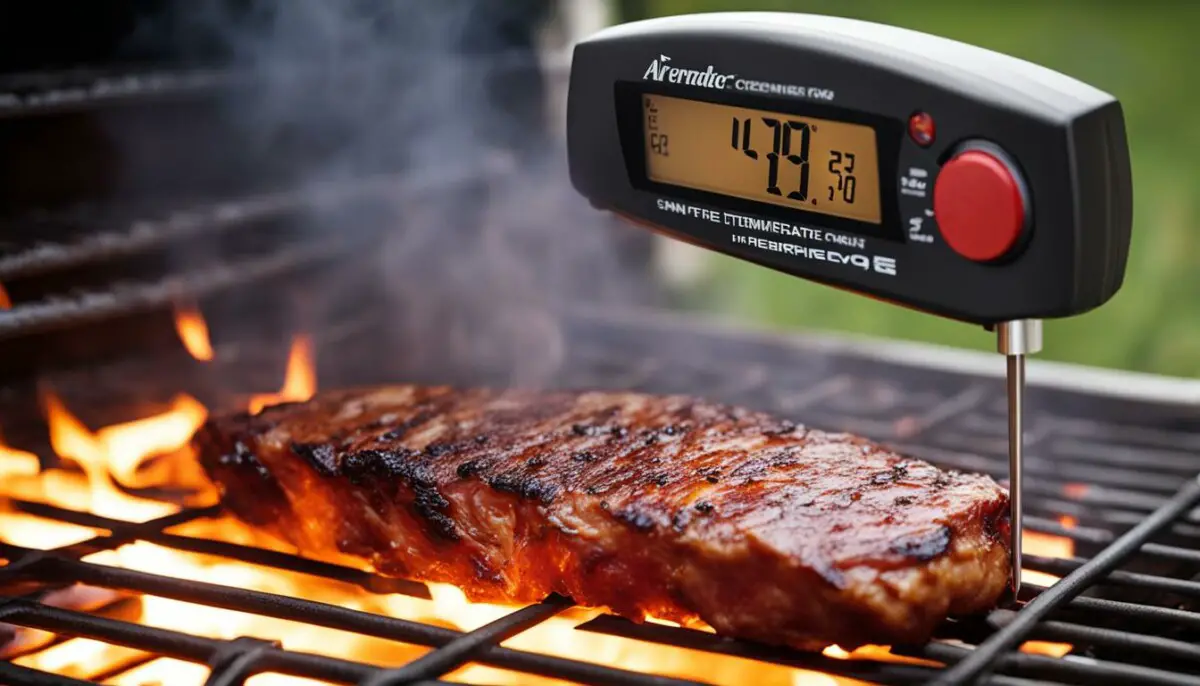
.jpg)
